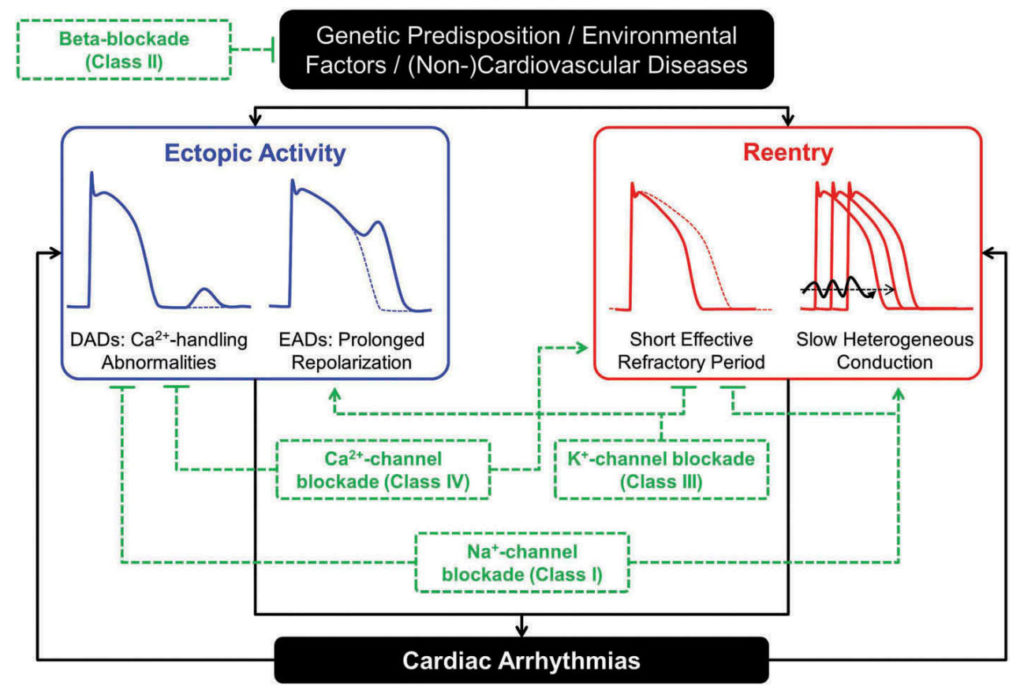Management of Cardiac Arrhythmias
Wendy A. Ware, John D. Bonagura
Cardiac arrhythmias present a number of challenges for the clinician. In all cases, any identified predisposing conditions should be managed, as possible. Signalment can be particularly important because some breeds have an increased prevalence of diseases associated with sudden arrhythmic death, including Boxers and Doberman Pinschers. The abolition of arrhythmias during exercise often is a favorable sign; whereas, their provocation with exertion is concerning, and in a horse, potentially dangerous to people. Cardiac arrhythmias can vary tremendously in frequency and severity over time. Ectopic complexes are identified and classified, as possible, by origin, site, and timing. Standards for choosing and continuing antiarrhythmic therapy are not clearly defined for many situations. Antiarrhythmic drugs might suppress potentially life-saving ventricular escape rhythms. Treatment goals for the individual patient also should be defined. Potential adverse effects of an antiarrhythmic drug must be considered against the desired benefits.
Catheter Ablation of Cardiac Arrhythmias in Children and Patients with Congenital Heart Disease
Edward P. Walsh, George F. Van Hare, Paul Khairy, Mohammad Shenasa
This authoritative book explores electrophysiologic testing and therapeutic catheter ablation for cardiac arrhythmias in children, and in patients of all ages with congenital heart disease. It reviews the anatomic and physiologic background to these procedures, emphasizing the tools for mapping and tissue ablation that continue to improve patient outcomes. Additionally, individual chapters are dedicated to specific congenital heart defects (for instance, tetralogy of Fallot, Ebstein’s anomaly, univentricular heart) guiding the reader to anticipate the type of arrhythmia, the most likely location for effective ablation, and the technical challenges that may be encountered in each condition.
Cardiac arrhythmias in congestive heart failure
Published in Expert Review of Cardiovascular Therapy
Congestive heart failure (CHF) is a common clinical syndrome worldwide. Collectively, in the USA and over 50 European countries, nearly 20 million people suffer from CHF [1,2]. Although survival after the onset of CHF has improved owing to better healthcare, the incidence of heart failure has not declined during the last 20 years, as a result of an increasing aging population, and the great increment in cardiovascular diseases that has been observed in developing countries [3,4]. Cardiac arrhythmias, whether symptomatic or not, and whether benign or lethally malignant, are common in all forms of heart failure. For example, in a patient with mitral valve regurgitation, the predominant arrhythmia may be atrial fibrillation (AF), which may lead to the further progression of CHF and severity of mitral regurgitation. On the other hand, in a patient with ischemic cardiomyopathy, cardiac arrhythmia may manifest in the form of ventricular tachycardia (VT) or ventricular fibrillation (VF), potentially leading to sudden cardiac death (SCD). Furthermore, both atrial and ventricular arrhythmias are often present in the same patient.
Does Physiologic Gastroesophageal Reflux Affect Heart Rate or Rhythm?
Published in Scandinavian Journal of Gastroenterology
An acid-induced, cholinergic esophagocardiac reflex has been observed in humans. Decrements of heart rate can be induced by direct intraesophageal acid infusion. To ascertain whether this reflex occurs during physiologic reflux and whether stimulation of this reflex might precipitate dysrhythmias, a prospective study was performed. Twenty consecutive patients referred for 24-h ambulatory intraesophageal pH monitoring underwent simultaneous 24-h cardiac holter monitoring. Analyses were performed only on gastroesophageal reflux episodes which resulted in esophageal acidification to pH <4 for 60 sec or more. Evaluable cardiac holter variables included premature ventricular contractions (PVCs), premature atrial contractions (PACs), tachycardia (heart rate, ≥110/min), and bradycardia (heart rate, <50/min). Measurements were made for 60 sec before and after onset of esophageal acidification. No relationship was noted between physiologic episodes of gastroesophageal reflux and PVCs (p = 0.29), PACs (p = 0.12), tachycardia (p = 0.33), or bradycardia (p = 0.78). No statistically significant correlations were noted between total 24-h acid exposure (minutes/24h) and mean heart rate (p = 0.07), number of PVCs (p = 0.41), and number of PACs (p = 0.39). Analyses of reflux episodes lasting more than 5 min with intraesophageal pH <2 also failed to show changes in pulse rate (p = 0.22). Physiologic gastroesophageal reflux does not induce changes in heart rate or rhythm in humans. It is possible that esophagocardiac reflexes noted during intraesophageal acid infusion are related to lower pH values or to other factors such as osmolarity, temperature, or site-specific receptors.
Cardiovascular safety of COVID-19 vaccines in real-world studies: a systematic review and meta-analysis
Published in Expert Review of Vaccines
The World Health Organization reported that, as of 23 June 2022, there have been a total of more than 539 million confirmed cases of COVID-19 including 6,324,112 cumulative deaths worldwide [1]. An effective and well-tolerated vaccine is an effective measure to reduce the infection rate and to curb the coronavirus pandemic.
Several large studies have evaluated that clinical trials of the COVID-19 vaccines have demonstrated a good safety [2] and efficacy [3]. COVID-19 vaccines, including the mRNA vaccine, adenovirus vector vaccine, inactivated vaccine, and the protein subunit vaccine, are available in different dosage and inter-dose intervals.
Although some vaccines have passed the safety test of phase III clinical trial, rare adverse events can only be reported in the real-world study after marketing. With the gradual reporting of COVID-19 vaccine-related cardiovascular events [2,4–7], the potential adverse event of vaccines raised hesitancy to vaccinate [8]. These may affect vaccination rates and may lead to a longer duration of the COVID-19 pandemic. Moreover, COVID-19 infection increases the risk of cardiovascular events. In addition, the recent emergence of more infectious and immune evasive mutants has made the management of outbreaks more difficult. Therefore, a realistic and objective assessment of vaccine safety has become a major concern for the international community.
 Africa
Africa  China
China  Japan
Japan 

